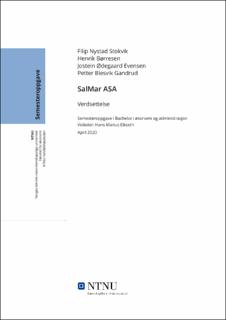| dc.contributor.advisor | Eikseth, Hans Marius | |
| dc.contributor.author | Børresen, Henrik | |
| dc.contributor.author | Evensen, Jostein Ødegaard | |
| dc.contributor.author | Gandrud, Petter Blesvik | |
| dc.contributor.author | Stokvik, Filip Nystad | |
| dc.date.accessioned | 2020-06-11T16:01:33Z | |
| dc.date.available | 2020-06-11T16:01:33Z | |
| dc.date.issued | 2020 | |
| dc.identifier.uri | https://hdl.handle.net/11250/2657782 | |
| dc.description.abstract | Vi har valgt følgende problemstilling: Hva er SalMar ASA verdt pr. 31.12.2019? For å besvare problemstillingen har vi benyttet sekundærdata og analysert regnskapstall fra perioden 2015-2019.
SalMar, med sin lange historie, har opplevd fenomenal vekst de siste årene, og har opparbeidet seg en solid posisjon som en av verdens største og mest effektive produsenter av oppdrettslaks. Av den strategiske analysen fremkommer det at de mest sentrale risikofaktorene som påvirker omsetningen til SalMar er knyttet til fremtidig laksepris, kronekurs og biologisk risiko. Videre ser vi at den politiske diskusjonen i Norge om innføring av grunnrenteskatt også medfører et usikkerhetsmoment. I den strategiske analysen konkluderer vi med at SalMar holder en sterk posisjon blant de norske produsentene av oppdrettslaks, i en bransje med gode vekstmuligheter og betydelig konkurranse.
Regnskapsanalysen viser at SalMar har en meget god lønnsomhet sammenlignet med både bransjen og generelle normer, særlig med tanke på driftsmarginen som var på 38% i 2018. Gjennom en analyse av nøkkeltallene ser vi også at økonomien til SalMar er svært solid. Basert på kjente regnskapsnormer har selskapet blant annet god egenkapitalandel, totalkapitalrentabilitet og lav gjeldsgrad.
I den finansielle analysen benytter vi den fundamentale DCF-metoden og verdsettelse basert på multipler. Ved DCF-metoden konkluderte vi med et estimat på 451,22 NOK og ved multippelmetoden fikk vi en aksjekurs på 424,34 NOK. Vi vektet resultatene med henholdsvis 60% og 40%, og får dermed en endelig aksjekurs på 440,47 NOK pr. 31.12.2019. Dette er 1,9% lavere enn den faktiske aksjekursen på 449,30 NOK. Vi konkluderer følgelig med at SalMar ASA er overpriset. Til slutt diskuterer vi svakheter ved oppgaven, da særlig med fokus på begrensede ressurser og svakheter ved verdsettelsesmetodene som ble benyttet. | |
| dc.description.abstract | We have chosen the following issue: How much is SalMar ASA worth per 31.12.2019? To answer the question, we have used secondary data and analyzed accounting figures from the period 2015-2019.
SalMar, with its long history, has experienced phenomenal growth in recent years and has gained a stable position as one of Norway's largest fish farming companies. The strategic analysis reveals that there is a particularly high risk associated with future salmon prices and macroeconomic factors such as the krone exchange rate, which is essential for SalMar's revenues. Furthermore, we see that the political discussion on the introduction of basic interest tax is a real element of uncertainty for the future. The strategic analysis concludes that SalMar holds a strong position among the Norwegian aquaculture companies, in an industry with both good growth and considerable competition.
The accounting analysis shows that SalMar has excellent profitability compared to both the industry and general norms, especially considering the operating margin of 38% in 2018. Through an analysis of the key figures, we also see that SalMar's economy is formidable. Based on known accounting standards, the company has - among other things - good equity ratio, the total return on capital and low debt ratio.
In the financial analysis, we use the fundamental DCF method and valuation based on multiples. By the DCF method, we concluded with an estimate of NOK 451.22, and by the multiples method, we got a share price of NOK 424.34. We weighted the results by 60% and 40% respectively, and thus receive a final share price of NOK 440.47 per 31.12.2019, which is 1.9% lower than the actual share price of NOK 449.30. Hence, conclusively SalMar ASA is overpriced. Lastly, we discuss weaknesses in the assignment, primarily focusing on limited resources and weaknesses in the valuation methods used. | |
| dc.language | nob | |
| dc.publisher | NTNU | |
| dc.title | SalMar ASA Verdsettelse | |
| dc.type | Bachelor thesis | |
